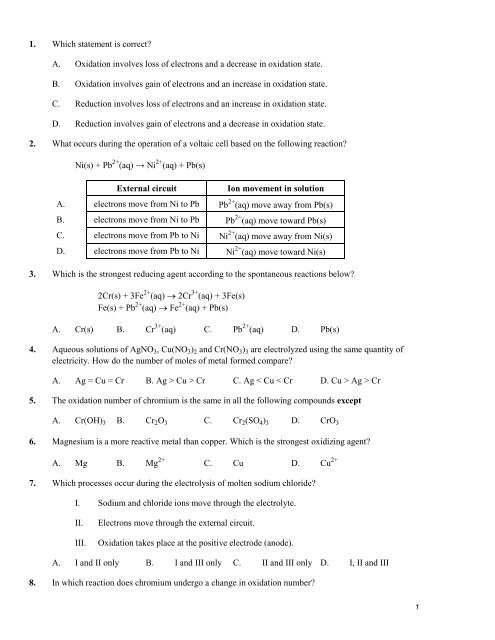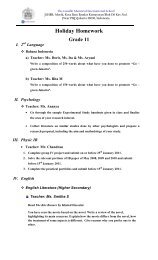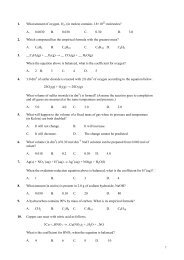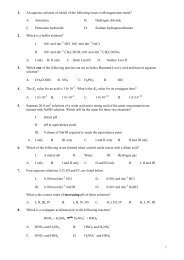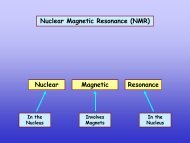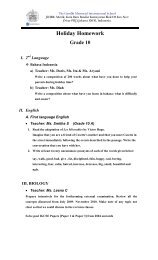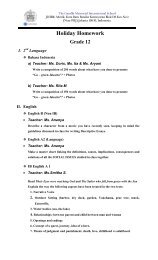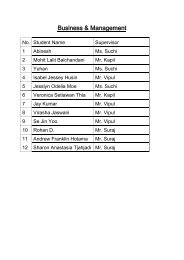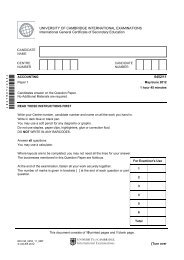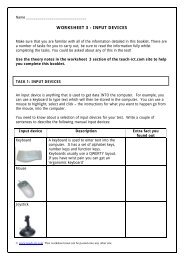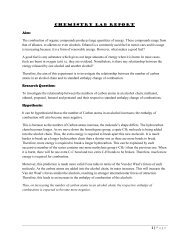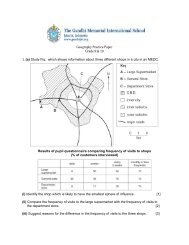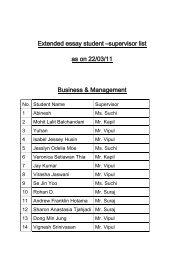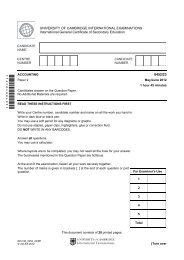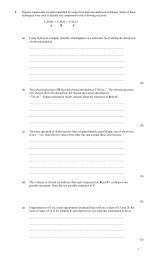Practise questions on oxidation and reduction
Practise questions on oxidation and reduction
Practise questions on oxidation and reduction
You also want an ePaper? Increase the reach of your titles
YUMPU automatically turns print PDFs into web optimized ePapers that Google loves.
1. Which statement is correct?A. Oxidati<strong>on</strong> involves loss of electr<strong>on</strong>s <strong>and</strong> a decrease in oxidati<strong>on</strong> state.B. Oxidati<strong>on</strong> involves gain of electr<strong>on</strong>s <strong>and</strong> an increase in oxidati<strong>on</strong> state.C. Reducti<strong>on</strong> involves loss of electr<strong>on</strong>s <strong>and</strong> an increase in oxidati<strong>on</strong> state.D. Reducti<strong>on</strong> involves gain of electr<strong>on</strong>s <strong>and</strong> a decrease in oxidati<strong>on</strong> state.2. What occurs during the operati<strong>on</strong> of a voltaic cell based <strong>on</strong> the following reacti<strong>on</strong>?Ni(s) + Pb 2+ (aq) → Ni 2+ (aq) + Pb(s)External circuitI<strong>on</strong> movement in soluti<strong>on</strong>A. electr<strong>on</strong>s move from Ni to Pb Pb 2+ (aq) move away from Pb(s)B. electr<strong>on</strong>s move from Ni to Pb Pb 2+ (aq) move toward Pb(s)C. electr<strong>on</strong>s move from Pb to Ni Ni 2+ (aq) move away from Ni(s)D. electr<strong>on</strong>s move from Pb to Ni Ni 2+ (aq) move toward Ni(s)3. Which is the str<strong>on</strong>gest reducing agent according to the sp<strong>on</strong>taneous reacti<strong>on</strong>s below?2Cr(s) + 3Fe 2+ (aq) 2Cr 3+ (aq) + 3Fe(s)Fe(s) + Pb 2+ (aq) Fe 2+ (aq) + Pb(s)A. Cr(s) B. Cr 3+ (aq) C. Pb 2+ (aq) D. Pb(s)4. Aqueous soluti<strong>on</strong>s of AgNO 3 , Cu(NO 3 ) 2 <strong>and</strong> Cr(NO 3 ) 3 are electrolyzed using the same quantity ofelectricity. How do the number of moles of metal formed compare?A. Ag = Cu = Cr B. Ag > Cu > Cr C. Ag < Cu < Cr D. Cu > Ag > Cr5. The oxidati<strong>on</strong> number of chromium is the same in all the following compounds exceptA. Cr(OH) 3 B. Cr 2 O 3 C. Cr 2 (SO 4 ) 3 D. CrO 36. Magnesium is a more reactive metal than copper. Which is the str<strong>on</strong>gest oxidizing agent?A. Mg B. Mg 2+ C. Cu D. Cu 2+7. Which processes occur during the electrolysis of molten sodium chloride?I. Sodium <strong>and</strong> chloride i<strong>on</strong>s move through the electrolyte.II.III.Electr<strong>on</strong>s move through the external circuit.Oxidati<strong>on</strong> takes place at the positive electrode (anode).A. I <strong>and</strong> II <strong>on</strong>ly B. I <strong>and</strong> III <strong>on</strong>ly C. II <strong>and</strong> III <strong>on</strong>ly D. I, II <strong>and</strong> III8. In which reacti<strong>on</strong> does chromium undergo a change in oxidati<strong>on</strong> number?1
Cd(s) + Sn 2+ (aq) → Cd 2+ (aq) + Sn(s)Sn(s) + Pb 2+ (aq) → Sn 2+ (aq) + Pb(s)Which of the following pairs will react sp<strong>on</strong>taneously?I. Sn(s) + Fe 2+ (aq) II. Cd(s) + Pb 2+ (aq) III. Fe(s) + Pb 2+ (aq)A. I <strong>on</strong>ly B. II <strong>on</strong>ly C. III <strong>on</strong>ly D. II <strong>and</strong> III <strong>on</strong>ly14. What species are produced at the positive <strong>and</strong> negative electrodes during the electrolysis of molten sodiumchloride?Positive electrode Negative electrodeA. Na + (l) Cl 2 (g)B. Cl – (l) Na + (l)C. Na(l) Cl 2 (g)D. Cl 2 (g) Na(l)15. What is the coefficient for H + when the equati<strong>on</strong> below is balanced?__Pb(s) + __NO – 3 (aq) + __H + (aq) → __Pb 2+ (aq) + __NO(g) + __H 2 O(l)A. 2 B. 4 C. 6 D. 816. Which of the following factors affect the amount of product formed during electrolysis?I. The current used II. The durati<strong>on</strong> of electrolysis III. The charge <strong>on</strong> the i<strong>on</strong>A. I <strong>and</strong> II <strong>on</strong>ly B. I <strong>and</strong> III <strong>on</strong>ly C. II <strong>and</strong> III <strong>on</strong>ly D. I, II <strong>and</strong> III17. C<strong>on</strong>sider the following reacti<strong>on</strong>.H 2 SO 3 (aq) + Sn 4+ (aq) + H 2 O(l) → Sn 2+ (aq) + HSO – 4 (aq) + 3H + (aq)Which statement is correct?A. H 2 SO 3 is the reducing agent because it undergoes reducti<strong>on</strong>.B. H 2 SO 3 is the reducing agent because it undergoes oxidati<strong>on</strong>.C. Sn 4+ is the oxidizing agent because it undergoes oxidati<strong>on</strong>.D. Sn 4+ is the reducing agent because it undergoes oxidati<strong>on</strong>.18. In which change does oxidati<strong>on</strong> occur?A. CH 3 CHO → CH 3 CH 2 OH B. CrO 4 2– → Cr 2 O 72–C. SO 4 2– → SO 32–D. NO 2 – → NO 3–19. What happens at the positive electrode in a voltaic cell <strong>and</strong> in an electrolytic cell?3
Voltaic cell Electrolytic cellA. Oxidati<strong>on</strong> Reducti<strong>on</strong>B. Reducti<strong>on</strong> Oxidati<strong>on</strong>C. Oxidati<strong>on</strong> Oxidati<strong>on</strong>D. Reducti<strong>on</strong> Reducti<strong>on</strong>20. The cyanide i<strong>on</strong>, CN – , can form two complex i<strong>on</strong>s with ir<strong>on</strong> i<strong>on</strong>s. The formulas of these i<strong>on</strong>s are [Fe(CN) 6 ] 4–<strong>and</strong> [Fe(CN) 6 ] 3– . What is the oxidati<strong>on</strong> number of ir<strong>on</strong> in the two complex i<strong>on</strong>s?[Fe(CN) 6 ] 4– [Fe(CN) 6 ] 3–A. –4 –3B. +2 +3C. +3 +2D. –3 –421. C<strong>on</strong>sider the following reacti<strong>on</strong>s.Cu 2+ (aq) + 2e – Cu(s) E ο = +0.34 VMg 2+ (aq) + 2e –Mg(s) E ο = –2.36 VZn 2+ (aq) + 2e – Zn(s) E ο = –0.76 VWhich statement is correct?A. Cu 2+ (aq) will oxidize both Mg(s) <strong>and</strong> Zn(s). B. Zn(s) will reduce both Cu 2+ (aq) <strong>and</strong> Mg 2+ (aq).C. Mg 2+ (aq) will oxidize both Cu(s) <strong>and</strong> Zn(s). D. Cu(s) will reduce both Mg 2+ (aq) <strong>and</strong> Zn 2+ (aq).22. C<strong>on</strong>sider the st<strong>and</strong>ard electrode potentials of the following reacti<strong>on</strong>s.Cr 3+ (aq) + 3e – →Cr(s)Cd 2+ (aq) + 2e – → Cd(s)–0.75 V–0.40 VWhat is the value of the cell potential (in V) for the following reacti<strong>on</strong>?2Cr(s) + 3Cd 2+ (aq) → 2Cr 3+ (aq) + 3Cd(s)A. –0.35 B. –1.15 C. +0.30 D. +0.3523. Aqueous soluti<strong>on</strong>s c<strong>on</strong>taining different c<strong>on</strong>centrati<strong>on</strong>s of NaCl were electrolysed using platinum electrodes.What is the major product at the positive electrode in each case?0.001 mol dm –3 NaCl(aq) 1.0 mol dm –3 NaCl(aq)A. H 2 NaB. H 2 H 24
C. O 2 Cl 2D. Cl 2 O 224. What are the oxidati<strong>on</strong> numbers of the elements in sulfuric acid, H 2 SO 4 ?Hydrogen Sulfur OxygenA. +1 +6 –2B. +1 +4 –2C. +2 +1 +4D. +2 +6 –825. A voltaic cell is made from copper <strong>and</strong> zinc half-cells. The equati<strong>on</strong> for the reacti<strong>on</strong> occurring in the cell isZn(s) + Cu 2+ (aq) → Zn 2+ (aq) + Cu(s)Which statement is correct when the cell produces electricity?A. Electr<strong>on</strong>s are lost from zinc atoms.B. The mass of the copper electrode decreases.C. Electr<strong>on</strong>s flow from the copper half-cell to the zinc half-cell.D. Negative i<strong>on</strong>s flow through the salt bridge from the zinc half-cell to the copper half-cell.26. What happens when molten sodium chloride is electrolysed in an electrolytic cell?A. Chlorine is produced at the positive electrode.B. Sodium i<strong>on</strong>s lose electr<strong>on</strong>s at the negative electrode.C. Electr<strong>on</strong>s flow through the liquid from the negative electrode to the positive electrode.D. Oxidati<strong>on</strong> occurs at the negative electrode <strong>and</strong> reducti<strong>on</strong> at the positive electrode.27. The unbalanced equati<strong>on</strong> for the c<strong>on</strong>versi<strong>on</strong> of sulfur dioxide to sulfuric acid is given below.___SO 2 + ___H 2 O → ___ H 2 SO 4Which other species are used, <strong>and</strong> <strong>on</strong> which side of the equati<strong>on</strong>, to balance it?A. H + <strong>and</strong> e – <strong>on</strong> the left B. H + <strong>on</strong> the left <strong>and</strong> e – <strong>on</strong> the rightC. H + <strong>on</strong> the right <strong>and</strong> e – <strong>on</strong> the left D. H + <strong>and</strong> e – <strong>on</strong> the right28. Which is a feature of the st<strong>and</strong>ard hydrogen electrode?A. hydrogen gas at 1.01×10 5 Pa (1 atm) pressure B. 1.0 mol dm –3 sulfuric acidC. a temperature of 273 K D. a magnesium electrode29. Which pair of factors both affect the amount (in mol) of chlorine produced in the electrolysis of aqueous5
sodium chloride?A. current <strong>and</strong> temperatureB. temperature <strong>and</strong> chloride i<strong>on</strong> c<strong>on</strong>centrati<strong>on</strong>C. chloride i<strong>on</strong> c<strong>on</strong>centrati<strong>on</strong> <strong>and</strong> length of time of electrolysisD. pressure <strong>and</strong> length of time of electrolysis30. Which equati<strong>on</strong>s represent reacti<strong>on</strong>s that occur at room temperature?I. 2Br – (aq) + Cl 2 (aq) 2Cl – (aq) + Br 2 (aq)II.III.2Br – (aq) + I 2 (aq) 2I – (aq) + Br 2 (aq)2I – (aq) + Cl 2 (aq) 2Cl – (aq) + I 2 (aq)A. I <strong>and</strong> II <strong>on</strong>ly B. I <strong>and</strong> III <strong>on</strong>ly C. II <strong>and</strong> III <strong>on</strong>ly D. I, II <strong>and</strong> III31. Which equati<strong>on</strong> represents a redox reacti<strong>on</strong>?A. KOH(aq) + HCl(aq) KCl(aq) + H 2 O(l) B. Mg(s) + 2HCl(aq) MgCl 2 (aq) + H 2 (g)C. CuO(s) + 2HCl(aq) CuCl 2 (aq) + H 2 O(l)D. ZnCO 3 (s) + 2HCl(aq) ZnCl 2 (aq) + CO 2 (g) + H 2 O(l)32. The following informati<strong>on</strong> is given about reacti<strong>on</strong>s involving the metals X, Y <strong>and</strong> Z <strong>and</strong> soluti<strong>on</strong>s of theirsulfates.X(s) + YSO 4 (aq) no reacti<strong>on</strong>Z(s) + YSO 4 (aq) Y(s) + ZSO 4 (aq)When the metals are listed in decreasing order of reactivity (most reactive first), what is the correct order?A. Z Y X B. X Y Z C. Y X Z D. Y Z X33. From the given st<strong>and</strong>ard electrode potentials which statement is correct?Ca 2+ (aq) + 2e – Ca(s) E Ө = –2.87 VNi 2+ (aq) + 2e – Ni(s) E Ө = –0.23 VFe 3+ (aq) + e – Fe 2+ (aq) E Ө = +0.77 VA. Ca 2+ (aq) can oxidize Ni(s) B. Ni 2+ (aq) can reduce Ca 2+ (aq)C. Fe 3+ (aq) can oxidize Ni(s) D. Fe 3+ (aq) can reduce Ca 2+ (aq)34. Which statement is correct about the electrolysis of copper(II) sulfate soluti<strong>on</strong> using graphite electrodes?A. A colourless gas is produced at the negative electrode.B. The electrolyte does not change colour. C. The negative electrode decreases in mass.6
D. A colourless gas is produced at the positive electrode.35. What are the oxidati<strong>on</strong> numbers of the elements in the compound phosphoric acid, H 3 PO 4 ?Hydrogen Phosphorus OxygenA. +1 +1 –2B. +1 +5 –2C. +3 +1 –4D. +3 +5 –836. A voltaic cell is made from magnesium <strong>and</strong> ir<strong>on</strong> half-cells. Magnesium is a more reactive metal than ir<strong>on</strong>.Which statement is correct when the cell produces electricity?A. Electr<strong>on</strong>s are lost from magnesium atoms. B. The c<strong>on</strong>centrati<strong>on</strong> of Fe 2+ i<strong>on</strong>s increases.C. Electr<strong>on</strong>s flow from the ir<strong>on</strong> half-cell to the magnesium half-cell.D. Negative i<strong>on</strong>s flow through the salt bridge from the magnesium half-cell to the ir<strong>on</strong> half-cell.37. A metallic object is electroplated with copper using a soluti<strong>on</strong> of copper(II) sulfate. Which statement iscorrect?A. The positive electrode increases in mass.B. The c<strong>on</strong>centrati<strong>on</strong> of Cu 2+ i<strong>on</strong>s in the soluti<strong>on</strong> decreases.C. Reducti<strong>on</strong> occurs at the positive electrode.D. The reacti<strong>on</strong> occurring at the negative electrode is Cu 2+ + 2e – Cu.38. Two half-equati<strong>on</strong>s <strong>and</strong> their st<strong>and</strong>ard electrode potentials are shown in the table.Half-equati<strong>on</strong>E Ө / VPb 2+ (aq) + 2e – Pb(s) –0.13Ag + (aq) + e – Ag(s) +0.80What is the cell potential, in V, for the reacti<strong>on</strong> below?Pb(s) + 2Ag + (aq) Pb 2+ (aq) + 2Ag(s)A. 0.67 B. 0.93 C. 1.47 D. 1.7339. Two electrolytic cells are c<strong>on</strong>nected in series so that the same current flows through both cells for the samelength of time.7
- +- +SnSO 4(aq)CuSO 4(aq)The amount of tin deposited is 0.01 mol. How much copper is deposited?A. 0.005 mol B. 0.01 mol C. 0.02 mol D. 0.05 mol40. Which are examples of reducti<strong>on</strong>?I. Fe 3+ becomes Fe 2+ II. Cl – becomes Cl 2 III. CrO 3 becomes Cr 3+A. I <strong>and</strong> II <strong>on</strong>ly B. I <strong>and</strong> III <strong>on</strong>ly C. II <strong>and</strong> III <strong>on</strong>ly D. I, II <strong>and</strong> III41. Which statement is correct for the electrolysis of a molten salt?A. Positive i<strong>on</strong>s move toward the positive electrode. B. A gas is produced at the negative electrode.C. Only electr<strong>on</strong>s move in the electrolyte.D. Both positive <strong>and</strong> negative i<strong>on</strong>s move toward electrodes.42. Which statement about the following reacti<strong>on</strong> is correct?2Br – (aq) + Cl 2 (aq) Br 2 (aq) + 2Cl – (aq)A. Br – (aq) is reduced <strong>and</strong> gains electr<strong>on</strong>s. B. Cl 2 (aq) is reduced <strong>and</strong> loses electr<strong>on</strong>s.C. Br – (aq) is oxidized <strong>and</strong> loses electr<strong>on</strong>s. D. Cl 2 (aq) is oxidized <strong>and</strong> gains electr<strong>on</strong>s.43. Which are used for the electroplating of a metal spo<strong>on</strong> with copper?I. an electrolyte c<strong>on</strong>taining aqueous copper(II) i<strong>on</strong>sII.III.a copper anode (positive electrode)a copper cathode (negative electrode)A. I <strong>and</strong> II <strong>on</strong>ly B. I <strong>and</strong> III <strong>on</strong>ly C. II <strong>and</strong> III <strong>on</strong>ly D. I, II <strong>and</strong> III44. C<strong>on</strong>sider these st<strong>and</strong>ard electrode potentials.Cu 2+ (aq) + e – Cu + (aq)Cu + (aq) + e – Cu(s)E Ө = +0.15 VE Ө = +0.52 VWhat is the st<strong>and</strong>ard cell potential when the two half-cells are c<strong>on</strong>nected?A. – 0.67 V B. – 0.37 V C. + 0.37 V D. + 0.67 V45. C<strong>on</strong>sider the following sp<strong>on</strong>taneous reacti<strong>on</strong>s.8
Fe(s) + Cu 2+ (aq) Fe 2+ (aq) + Cu(s)Cu(s) + 2Ag + (aq) Cu 2+ (aq) + 2Ag(s)Zn(s) + Fe 2+ (aq) Zn 2+ (aq) + Fe(s)Which is the correct combinati<strong>on</strong> of str<strong>on</strong>gest oxidizing agent <strong>and</strong> str<strong>on</strong>gest reducing agent?Str<strong>on</strong>gest oxidizing agentStr<strong>on</strong>gest reducing agentA. Ag(s) Zn(s)B. Ag + (aq) Zn(s)C. Zn 2+ (aq) Ag(s)D. Zn(s) Ag + (aq)46. In which change does nitrogen undergo oxidati<strong>on</strong>?A. NO 2 N 2 O 4 B. NO 3 – NO 2 C. N 2 O 5 NO 3–D. NH 3 N 247. Which statement is correct?A. Sp<strong>on</strong>taneous redox reacti<strong>on</strong>s produce electricity in an electrolytic cell.B. Electricity is used to carry out a n<strong>on</strong>-sp<strong>on</strong>taneous redox reacti<strong>on</strong> in a voltaic cell.C. Oxidati<strong>on</strong> takes place at the negative electrode in a voltaic cell <strong>and</strong> the positive electrode in anelectrolytic cell.D. Oxidati<strong>on</strong> takes place at the negative electrode in a voltaic cell <strong>and</strong> reducti<strong>on</strong> takes place at the positiveelectrode in an electrolytic cell.48. The compound [Co(NH 3 ) 5 Br]SO 4 is isomeric with the compound [Co(NH 3 ) 5 SO 4 ]Br. What is the oxidati<strong>on</strong>state of cobalt in these compounds?[Co(NH 3 ) 5 Br]SO 4[Co(NH 3 ) 5 SO 4 ]BrA. +3 +3B. +2 +1C. +3 +2D. +2 +349. C<strong>on</strong>sider the st<strong>and</strong>ard electrode potentials of the following reacti<strong>on</strong>s:Sn 4+ (aq) + 2e – Sn 2+ (aq)Fe 3+ (aq) + e – Fe 2+ (aq)+0.15 V+0.77 VWhat is the value of the cell potential (in volts) for the sp<strong>on</strong>taneous reacti<strong>on</strong>?A. +1.69 B. +1.39 C. +0.92 D. +0.6250. In the electrolysis of acidified water, if 8.4 cm 3 of hydrogen gas is evolved, what volume of oxygen gas isevolved?9
A. 4.2 cm 3 B. 8.4 cm 3 C. 12.6 cm 3 D. 16.8 cm 351. Which factors affect the amount of metal formed during electrolysis?I. Charge <strong>on</strong> the metal i<strong>on</strong> II. Current III. TimeA. I <strong>and</strong> II <strong>on</strong>ly B. I <strong>and</strong> III <strong>on</strong>ly C. II <strong>and</strong> III <strong>on</strong>ly D. I, II <strong>and</strong> III52. What happens to vanadium during the reacti<strong>on</strong> VO 2+ (aq) VO – 3 (aq)?A. It undergoes oxidati<strong>on</strong> <strong>and</strong> its oxidati<strong>on</strong> number changes from +4 to +5.B. It undergoes oxidati<strong>on</strong> <strong>and</strong> its oxidati<strong>on</strong> number changes from +2 to +4.C. It undergoes reducti<strong>on</strong> <strong>and</strong> its oxidati<strong>on</strong> number changes from +2 to –1.D. It undergoes reducti<strong>on</strong> <strong>and</strong> its oxidati<strong>on</strong> number changes from +4 to +2.53. What occurs during the electrolysis of a molten salt?A. Electricity is produced by a sp<strong>on</strong>taneous redox reacti<strong>on</strong>.B. Electricity is used to cause a n<strong>on</strong>-sp<strong>on</strong>taneous redox reacti<strong>on</strong> to occur.C. Electr<strong>on</strong>s flow through the molten salt.D. Electr<strong>on</strong>s are removed from both i<strong>on</strong>s of the molten salt.54. Which statement is correct about an oxidizing agent in a chemical reacti<strong>on</strong>?A. It reacts with oxygen. B. It reacts with H + i<strong>on</strong>s.C. It loses electr<strong>on</strong>s. D. It undergoes reducti<strong>on</strong>.55. Which formula represents an aldehyde?A. CH 3 CH 2 CHO B. CH 3 COCH 3C. CH 3 CH 2 COOH D. CH 3 COOCH 356. The st<strong>and</strong>ard electrode potentials for two half reacti<strong>on</strong>s areV 2+ (aq) + 2e – V(s)Tl + (aq) + e – Tl(s)–1.19 V–0.34 VWhat is the E Ө value (in volts) for the following reacti<strong>on</strong>?V(s) + 2Tl + (aq) V 2+ (aq) + 2Tl(s)A. +0.85 B. +0.51 C. –1.53 D. –1.8710
……………………………………………………………………………………(1)(ii)Write a half-equati<strong>on</strong> for the oxidati<strong>on</strong> reacti<strong>on</strong>.…………………………………………………………………………………………………………………………………………………………………………(1)(iii)The above reacti<strong>on</strong>s are carried out under st<strong>and</strong>ard c<strong>on</strong>diti<strong>on</strong>s.State what the st<strong>and</strong>ard c<strong>on</strong>diti<strong>on</strong>s are for the cell.………………………………………………………………………………………………………………………………………………………………………………………………………………………………………………………………(iv)Using the Data Booklet, calculate the cell potential for the above cell.……………………………………………………………………………………………………………………………………………………………………………………………………………………………………………………………………………………………………………………………………………………(2)(v)State <strong>and</strong> explain what happens to the c<strong>on</strong>centrati<strong>on</strong> of the copper(II) i<strong>on</strong>s when the cell isproducing an electric current.…………………………………………………………………………………………………………………………………………………………………………(2)(vi)State two observati<strong>on</strong>s that could be made if the zinc rod were placed in a soluti<strong>on</strong> of copper(II)i<strong>on</strong>s.…………………………………………………………………………………………………………………………………………………………………………(2)(b)The st<strong>and</strong>ard electrode potentials for three electrode systems are given below.Ti 3+ (aq) + e – Ti 2+ (aq) E ο = –0.37 VFe 3+ (aq) + e – Fe 2+ (aq)Ce 4+ (aq) + e – Ce 3+ (aq)E ο = +0.77 VE ο = +1.45 V(i)Using the data above, deduce which species is the best reducing agent, giving a reas<strong>on</strong> in termsof electr<strong>on</strong>s for your answer.13
66.– +AXYCuSO (aq) 4Two copper strips X <strong>and</strong> Y are placed in an aqueous soluti<strong>on</strong> of copper(II) sulfate <strong>and</strong> electrolyzed for acertain time. X was then dried <strong>and</strong> weighed.(i) State <strong>and</strong> explain what would happen to the mass of X.…………………………………………………………………………………………..…………………………………………………………………………………………..…………………………………………………………………………………………..(3)(ii)State two ways in which the change in the mass of X could be increased.…………………………………………………………………………………………..…………………………………………………………………………………………..(2)(Total 5 marks)67. C<strong>on</strong>sider the following redox equati<strong>on</strong>.5Fe 2+ (aq) +MnO 4 – (aq) +8H + (aq) → 5Fe 3+ (aq) + Mn 2+ (aq) + 4H 2 O(l)(i)Determine the oxidati<strong>on</strong> numbers for Fe <strong>and</strong> Mn in the reactants <strong>and</strong> in the products.……………………………………………………………………………………………………………………………………………………………………………………………………………………………………………………………………………………………………………………………………………………………………………………(2)(ii)Based <strong>on</strong> your answer to (i), deduce which substance is oxidized.……………………………………………………………………………………………(1)15
(iii)The compounds CH 3 OH <strong>and</strong> CH 2 O c<strong>on</strong>tain carb<strong>on</strong> atoms with different oxidati<strong>on</strong> numbers. Deducethe oxidati<strong>on</strong> numbers <strong>and</strong> state the kind of chemical change needed to make CH 2 O from CH 3 OH.………………………………………………………………………………………………………………………………………………………………………………………………………………………………………………………………………………………(3)(Total 6 marks)68. A part of the reactivity series of metals, in order of decreasing reactivity, is shown below.magnesiumzincir<strong>on</strong>leadcoppersilverIf a piece of copper metal were placed in separate soluti<strong>on</strong>s of silver nitrate <strong>and</strong> zinc nitrate(i)determine which soluti<strong>on</strong> would undergo reacti<strong>on</strong>.……………………………………………………………………………………………(1)(ii)identify the type of chemical change taking place in the copper <strong>and</strong> write thehalf-equati<strong>on</strong> for this change.…………………………………………………………………………………………………………………………………………………………………………………………(2)(iii)state, giving a reas<strong>on</strong>, what visible change would take place in the soluti<strong>on</strong>s.……………………………………………………………………………………………………………………………………………………………………………………………………………………………………………………………………………………………………………………………………………………………………………………(2)(Total 5 marks)69. (i) Solid sodium chloride does not c<strong>on</strong>duct electricity but molten sodium chloride does. Explain thisdifference, <strong>and</strong> outline what happens in an electrolytic cell during the electrolysis of molten sodiumchloride using carb<strong>on</strong> electrodes.………………………………………………………………………………………………………………………………………………………………………………………………………………………………………………………………………………………16
…………………………………………………………………………………………………………………………………………………………………………………………………………………………………………………………………………………………………………………………………………………………………………………………………………………………………………………………………………………(4)(ii)State the products formed <strong>and</strong> give equati<strong>on</strong>s showing the reacti<strong>on</strong>s at each electrode.……………………………………………………………………………………………………………………………………………………………………………………………………………………………………………………………………………………………………………………………………………………………………………………(4)(iii)State what practical use is made of this process.…………………………………………………………………………………………………………………………………………………………………………………………(1)(Total 9 marks)70. (a) Some st<strong>and</strong>ard electrode potentials are shown in Table 15 of the Data Booklet.(i)State three c<strong>on</strong>diti<strong>on</strong>s under which the hydrogen electrode is assigned a potential of zero.………………………………………………………………………………………………………………………………………………………………………………………………………………………………………………………………………(3)(ii)Calculate the cell potential of a cell made by c<strong>on</strong>necting st<strong>and</strong>ard copper <strong>and</strong> zinc electrodes.State the directi<strong>on</strong> of electr<strong>on</strong> flow in the external circuit when the cell produces current. Outlinethe changes occurring at the electrodes <strong>and</strong> in the soluti<strong>on</strong>s during the process.………………………………………………………………………………………………………………………………………………………………………………………………………………………………………………………………………………………………………………………………………………………………………………………………………………………………………………………………………………………………………………………………………………17
………………………………………………………………………………………………………………………………………………………………………………(5)(b)Using informati<strong>on</strong> from Table 15, determine whether or not there is a sp<strong>on</strong>taneous reacti<strong>on</strong> betweencopper metal <strong>and</strong> a soluti<strong>on</strong> c<strong>on</strong>taining hydrogen i<strong>on</strong>s.……………………………………………………………………………………………………………………………………………………………………………………………………………………………………………………………………………………………………………………………………………………………………………………(2)(c)Using informati<strong>on</strong> from Table 15, identify a substance that will oxidize bromide i<strong>on</strong>s but not chloridei<strong>on</strong>s. Explain your choice, <strong>and</strong> write an equati<strong>on</strong> for the redox reacti<strong>on</strong> you have chosen.…………………………………………………………………………………………………………………………………………………………………………………………………………………………………………………………………………………………………………………………………………………………………………………………………………………………………………………………………………………(5)(Total 15 marks)71. A current is passed through molten sodium chloride. Identify the substance formed at each electrode <strong>and</strong>write an equati<strong>on</strong> to represent the formati<strong>on</strong> of each substance. Determine the mole ratio in which thesubstances are formed.………………………………………………………………………………………………………………………………………………………………………………………………………………………………………………………………………………………………………………………………………………………………………………………………………………………………………………………………………………………………………………………………………………………………………………………………………………………………(Total 5 marks)72. Electrolysis can be used to obtain chlorine from molten sodium chloride. Write an equati<strong>on</strong> for the reacti<strong>on</strong>occurring at each electrode <strong>and</strong> describe the two different ways in which electricity is c<strong>on</strong>ducted when thecell is in operati<strong>on</strong>.(Total 4 marks)73. (a) In <strong>on</strong>e experiment involving the electrolysis of molten sodium chloride, 0.1 mol of chlorine wasformed. Deduce, giving a reas<strong>on</strong>, the amount of sodium formed at the same time.(2)18
(b)In another experiment involving the electrolysis of molten sodium chloride, the time of the electrolysiswas halved <strong>and</strong> the current increased from 1 amp to 5 amp, compared to the experiment in (a). Deducethe amount of chlorine formed, showing your working.(2)(c)If dilute aqueous sodium chloride is electrolyzed, a different product is obtained at each electrode.Identify the product formed at each electrode <strong>and</strong> write an equati<strong>on</strong> showing its formati<strong>on</strong>.(4)(Total 8 marks)74. Two reacti<strong>on</strong>s occurring in the manufacture of bromine from sea water areIIICl 2 (g) + 2Br – (aq) 2Cl – (aq) + Br 2 (g)Br 2 (g) + SO 2 (g) + 2H 2 O(l) 2HBr(g) + H 2 SO 4 (g)(i)Explain, by reference to electr<strong>on</strong>s, why reacti<strong>on</strong> I is referred to as a redox reacti<strong>on</strong>.(2)(ii)State <strong>and</strong> explain whether SO 2 is reduced or oxidized in reacti<strong>on</strong> II by referring to the oxidati<strong>on</strong>numbers of sulfur in this reacti<strong>on</strong>.(3)(Total 5 marks)75. Define the term st<strong>and</strong>ard electrode potential of an element. Table 15 of the Data Booklet c<strong>on</strong>tains E Ө valuesfor two reacti<strong>on</strong>s involving O 2 (g). Identify the E Ө value of the reacti<strong>on</strong> that could be used to oxidize bromidei<strong>on</strong>s <strong>and</strong> explain your reas<strong>on</strong>ing. C<strong>on</strong>struct a balanced equati<strong>on</strong> for the oxidati<strong>on</strong> of bromide i<strong>on</strong>s using thisreacti<strong>on</strong> <strong>and</strong> calculate the cell potential.(Total 8 marks)76. In terms of electr<strong>on</strong> transfer define:(i)oxidati<strong>on</strong>........................................................................................................................................................................................................................................................................(1)(ii)oxidizing agent........................................................................................................................................................................................................................................................................(1)(Total 2 marks)77. Deduce the change in oxidati<strong>on</strong> number of chromium in the below reacti<strong>on</strong>. State with a reas<strong>on</strong> whether thechromium has been oxidized or reduced.CrO 7 2 + 14H + + 6Fe 2+ 2Cr 3+ + 6Fe 3+ + 7H 2 O..........................................................................................................................................................................................................................................................................................................................................................................................................................................19
..............................................................................................................................................(Total 2 marks)78. (a) (i) Define oxidizing agent in terms of electr<strong>on</strong> transfer...................................................................................................................................................................................................................................................(1)(ii)Deduce the change in oxidati<strong>on</strong> number of chromium in the reacti<strong>on</strong> below. State with a reas<strong>on</strong>whether the chromium has been oxidized or reduced.Cr 2 O 2 7 + 14H + + 6Fe 2+ 2Cr 3+ + 7H 2 O....................................................................................................................................................................................................................................................................................................................................................................................................................................................................................................(2)(Total 3 marks)79. Ir<strong>on</strong> in food, in the form of Fe 3+ , reacts with ascorbic acid (vitamin C), C 6 H 8 O 6 , to form dehydroascorbicacid, C 6 H 6 O 6 .(i)Write an i<strong>on</strong>ic half-equati<strong>on</strong> to show the c<strong>on</strong>versi<strong>on</strong> of ascorbic acid to dehydroascorbic acid inaqueous soluti<strong>on</strong>...................................................................................................................................................................................................................................................(1)(ii)In the other i<strong>on</strong>ic half-equati<strong>on</strong> Fe 3+ is c<strong>on</strong>verted to Fe 2+ . Deduce the overall equati<strong>on</strong> for thereacti<strong>on</strong> between C 6 H 8 O 6 <strong>and</strong> Fe 3+ ...................................................................................................................................................................................................................................................(1)(Total 2 marks)80. (i) Draw a diagram of apparatus that could be used to electrolyse molten potassium bromide. Label thediagram to show the polarity of each electrode <strong>and</strong> the product formed.(3)(ii)(iii)Describe the two different ways in which electricity is c<strong>on</strong>ducted in the apparatus.Write an equati<strong>on</strong> to show the formati<strong>on</strong> of the product at each electrode.(2)(2)(Total 7 marks)20
81. Use informati<strong>on</strong> from Table 15 of the Data Booklet, where relevant, in answering this part.(i)The diagram shows the apparatus used in an experiment involving half-cells.NickelVoltmeterLeadSoluti<strong>on</strong> c<strong>on</strong>taining2+Ni (aq)Soluti<strong>on</strong> c<strong>on</strong>taining2Pb (aq)The reading <strong>on</strong> the voltmeter is 0.10 V. State two st<strong>and</strong>ard c<strong>on</strong>diti<strong>on</strong>s that apply for this reading to beobtained.(ii) The voltmeter is replaced by a 2 volt power supply, so that n<strong>on</strong>-sp<strong>on</strong>taneous reacti<strong>on</strong>s occur. Deducethe half-equati<strong>on</strong>s for these reacti<strong>on</strong>s.(iii) Chlorine gas is formed when potassium manganate(VII) is added to c<strong>on</strong>centrated hydrochloric acid.Calculate the cell potential for this reacti<strong>on</strong> <strong>and</strong> deduce the equati<strong>on</strong> for the reacti<strong>on</strong>.(2)(2)(3)(iv)Explain why potassium dichromate(VI) does not react with c<strong>on</strong>centrated hydrochloric acid.(1)(Total 8 marks)82. Iodide i<strong>on</strong>s, I – (aq), react with iodate i<strong>on</strong>s, IO 3 – (aq), in an acidic soluti<strong>on</strong> to form molecular iodine <strong>and</strong> water.(i)Determine the oxidati<strong>on</strong> number of iodine in each iodine-c<strong>on</strong>taining species in the reacti<strong>on</strong>.............................................................................................................................................................................................................................................................................................................................................................................................................(2)(ii)Identify, with a reas<strong>on</strong>, the species that undergoes:oxidati<strong>on</strong> ........................................................................................................................................................................................................................................................reducti<strong>on</strong> ........................................................................................................................................................................................................................................................(2)(Total 4 marks)83. (a) When a c<strong>on</strong>centrated aqueous soluti<strong>on</strong> of sodium chloride is electrolyzed using inert electrodes, adifferent gas is produced at each electrode.(i)Write equati<strong>on</strong>s for the oxidati<strong>on</strong> <strong>and</strong> reducti<strong>on</strong> half-reacti<strong>on</strong>s.Oxidati<strong>on</strong> half-reacti<strong>on</strong>: ...................................................................................21
...........................................................................................................................Reducti<strong>on</strong> half-reacti<strong>on</strong>: ..............................................................................................................................................................................................................(2)(ii) Explain why sodium is not formed during the electrolysis of aqueous NaCl soluti<strong>on</strong>.......................................................................................................................................................................................................................................................(1)(b)Deduce the products formed during the electrolysis of an aqueous soluti<strong>on</strong> of sodium fluoride. Writean equati<strong>on</strong> for the reacti<strong>on</strong> at the positive electrode (the anode) <strong>and</strong> give your reas<strong>on</strong>ing...........................................................................................................................................................................................................................................................................................................................................................................................................................................................................................................................................................................................................................................................................................................................................................................................................................................................................................................................................................................(4)(Total 7 marks)84. The following are st<strong>and</strong>ard electrode potentials.Half-equati<strong>on</strong>E ο / VZn 2+ (aq) + 2e – Zn(s) –0.76Cr 3+ (aq) + 3e – Cr(s) –0.74Fe 2+ (aq) + 2e – Fe(s) –0.44Sn 2+ (aq) + 2e – Sn(s) –0.14Cu 2+ (aq) + 2e – Cu(s) +0.34Fe 3+ (aq) + e – Fe 2+ (aq) +0.77(a)These values were obtained using a st<strong>and</strong>ard hydrogen electrode. Describe the materials <strong>and</strong> c<strong>on</strong>diti<strong>on</strong>sused in the st<strong>and</strong>ard hydrogen electrode. (A suitably labelled diagram is acceptable.)…………………………………………………………………………………………………………………………………………………………………………………………………………………………………………………………………………………………………………………………………………………………………………………………………………………………………………………………………………………22
………………………………………………………………………………………………………………………………………………………………………………………………………………………………………………………………………………………(5)(b)Define the term oxidizing agent in terms of electr<strong>on</strong> transfer <strong>and</strong> identify the str<strong>on</strong>gest oxidizing agentin the list above.………………………………………………………………………………………………………………………………………………………………………………………………………………………………………………………………………………………(2)(c)A cell was set up using zinc in zinc sulfate soluti<strong>on</strong> <strong>and</strong> copper in copper(II) sulfate soluti<strong>on</strong>, bothsoluti<strong>on</strong>s being under st<strong>and</strong>ard c<strong>on</strong>diti<strong>on</strong>s.(i)Calculate the cell potential.…………………………………………………………………………………………………………………………………………………………………………(1)(ii)Write an equati<strong>on</strong> for the sp<strong>on</strong>taneous cell reacti<strong>on</strong>.………………………………………………………………………………………………………………………………………………………………………………………………………………………………………………………………(2)(d)Both zinc <strong>and</strong> tin are used to coat ir<strong>on</strong> to prevent it from rusting. Once the surface is scratched, oxygen<strong>and</strong> water c<strong>on</strong>taining dissolved i<strong>on</strong>s come into c<strong>on</strong>tact with the ir<strong>on</strong> <strong>and</strong> the coating metal.(i)State <strong>and</strong> explain whether zinc or tin would be more effective in preventing ir<strong>on</strong> from rustingunder these c<strong>on</strong>diti<strong>on</strong>s.……………………………………………………………………………………………………………………………………………………………………………………………………………………………………………………………………………………………………………………………………………………(2)(ii)Electroplating may be used to coat <strong>on</strong>e metal with another metal. Identify the three factorsaffecting the amount of metal discharged during electroplating.…………………………………………………………………………………………………………………………………………………………………………23
……………………………………………………………………………………(3)(iii)Explain why electrolysis of aqueous zinc sulfate is not used for coating with zinc metal.……………………………………………………………………………………………………………………………………………………………………………………………………………………………………………………………………………………………………………………………………………………(2)(e)Another cell was set up as shown below.VPt(s)Cr(s)2+Fe (aq), Fe (aq)Cr (aq)3+ 3+Yhalf-cell Ahalf-cell B(i)Identify the part of the cell labelled Y <strong>and</strong> outline its functi<strong>on</strong>.………………………………………………………………………………………………………………………………………………………………………………………………………………………………………………………………(2)(ii)Write an equati<strong>on</strong> for the initial reacti<strong>on</strong>s at each electrode <strong>and</strong> hence write an equati<strong>on</strong> for thecell reacti<strong>on</strong>.……………………………………………………………………………………………………………………………………………………………………………………………………………………………………………………………………………………………………………………………………………………(4)(iii) Describe the directi<strong>on</strong> of electr<strong>on</strong> flow in the external circuit.……………………………………………………………………………………(1)24
(iv)Calculate the cell potential.…………………………………………………………………………………………………………………………………………………………………………(1)(Total 25 marks)85. The following diagram shows a voltaic cell.voltmeterVsalt bridgeir<strong>on</strong> electrodesilver electrode2+Fe (aq)+Ag (aq)(a)State an equati<strong>on</strong> to represent the sp<strong>on</strong>taneous reacti<strong>on</strong> occurring in the cell.........................................................................................................................................................................................................................................................................(1)(b)Define the term st<strong>and</strong>ard electrode potential.........................................................................................................................................................................................................................................................................(1)(c)Use Table 15 from the Data Booklet to calculate the st<strong>and</strong>ard cell potential for the sp<strong>on</strong>taneousreacti<strong>on</strong> in (a).....................................................................................................................................(d)....................................................................................................................................Draw arrows <strong>on</strong> the above diagram to indicate the directi<strong>on</strong> of electr<strong>on</strong> flow.(1)(1)(Total 4 marks)86. Tin(II) i<strong>on</strong>s can be oxidized to tin(IV) i<strong>on</strong>s by acidified potassium permanganate(VII) soluti<strong>on</strong> according tothe following unbalanced equati<strong>on</strong>.__ Sn 2+ + __MnO 4 – + __ H + __ Sn 4+ + __Mn 2+ + __ H 2 O25
(a)Identify the oxidizing agent <strong>and</strong> the reducing agent.Oxidizing agent .........................................................................................................Reducing agent ..........................................................................................................(1)(b)Balance the equati<strong>on</strong> above.........................................................................................................................................................................................................................................................................(1)(Total 2 marks)87. (a) Iodide i<strong>on</strong>s, I – (aq), react with iodate i<strong>on</strong>s, IO – 3 (aq), in an acidic soluti<strong>on</strong> to form molecular iodine <strong>and</strong>water.(i) Determine the oxidati<strong>on</strong> number of iodine in I – <strong>and</strong> in IO 3 – ..........................................................................................................................(1)(ii)Identify, with a reas<strong>on</strong>, the species that undergoes:oxidati<strong>on</strong> ....................................................................................................................................................................................................................................reducti<strong>on</strong> ....................................................................................................................................................................................................................................(2)(iii)Write an i<strong>on</strong>ic equati<strong>on</strong> for the reacti<strong>on</strong> of I – with IO 3 – in an acidic soluti<strong>on</strong>...............................................................................................................................................................................................................................................................................................................................................................................(2)(b)Use informati<strong>on</strong> from Table 15 of the Data Booklet to calculate the cell potential for the followingreacti<strong>on</strong> <strong>and</strong> state whether or not the reacti<strong>on</strong> is sp<strong>on</strong>taneous.Cu(s) + Cu 2+ (aq) 2Cu + (aq)................................................................................................................................................................................................................................................................................................................................................................................................................................................................................................................................................(3)26
(Total 8 marks)88. A table of st<strong>and</strong>ard electrode potentials can be found in Table 14 of the Data Booklet.(a)Describe the materials <strong>and</strong> c<strong>on</strong>diti<strong>on</strong>s used in the st<strong>and</strong>ard hydrogen electrode.....................................................................................................................................................................................................................................................................................................................................................................................................................................................................................................................................................(5)(b)Define the term oxidizing agent in terms of electr<strong>on</strong> transfer <strong>and</strong> identify the str<strong>on</strong>gest oxidizing agentin Table 14 of the Data Booklet................................................................................................................................................................................................................................................................................................................................................................................................................(2)(c)A cell was set up using tin in tin(II) sulfate soluti<strong>on</strong> <strong>and</strong> copper in copper(II) sulfate soluti<strong>on</strong>, with bothsoluti<strong>on</strong>s under st<strong>and</strong>ard c<strong>on</strong>diti<strong>on</strong>s.(i)Calculate the cell potential.......................................................................................................................................................................................................................................................(1)(ii)Write an equati<strong>on</strong> for the sp<strong>on</strong>taneous cell reacti<strong>on</strong>.......................................................................................................................................................................................................................................................(2)27


